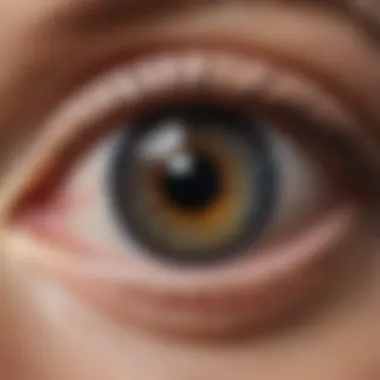Infection Risks After Cataract Surgery: Causes and Care


Intro
Cataract surgery is one of the most common and generally safe procedures performed worldwide. Yet, as with any surgical intervention, there are potential complications that patients need to be aware of. One of the most serious of these is infection, which can lead to significant consequences for vision and overall eye health. Understanding the root causes of these infections, the associated risks, and how to effectively manage them is crucial for both healthcare professionals and patients.
Infections following cataract surgery can take various forms, from mild conjunctivitis to the more severe endophthalmitis. Each type of infection presents unique challenges requiring a tailored approach to treatment and prevention. This article seeks to dissect these complexities, drawing on recent studies and expert opinions to furnish readers with a comprehensive understanding of infection management after cataract procedures.
Foreword to Cataract Surgery
Cataract surgery represents a significant advancement in ocular medicine, addressing a common ailment affecting countless individuals globally. The very act of removing cloudy lenses and replacing them with artificial ones is a life-altering procedure, igniting new hope for those beset by vision impairment. As we unpack this section, it is essential to appreciate not just the surgical technique, but the broader implications of these operations on the quality of life for patients.
Overview of Cataracts
A cataract essentially forms when proteins in the eye lens become cloudy, obstructing clear vision. Over time, this condition can progress to the point of near-complete blindness if left untreated. Age is the most notable factor, but other reasons can play a role: genetic predisposition, diabetes, or even prolonged exposure to ultraviolet light.
Understanding that cataracts can develop slowly and often go unnoticed until significant vision loss occurs is crucial, as it underscores the importance of regular eye examinations. For many, the path to cataract surgery is unavoidable, and recognizing the signs early can make all the difference.
Cataract Surgery Procedures
When it comes to the nitty-gritty of the surgical procedure, there are primarily two techniques used: phacoemulsification and extracapsular cataract extraction. Phacoemulsification is the more common option, involving a small incision through which an ultrasonic device breaks up the cloudy lens. This method typically leads to faster recovery.
Extracapsular extraction, on the other hand, is generally reserved for more complex cases, necessitating a larger incision to remove the lens intact. No matter the approach, cataract surgery is considered safe and effective, boasting high success rates. Patients typically report immediate improvements in vision, which often is quite astounding.
Importance of Surgical Technique
The intricacies of surgical technique cannot be overstated. An adept surgeon employs precision and skill, ensuring minimal risk of complications. Each step, from anesthesia choices to lens implantation, demands meticulous attention.
Success hinges significantly on pre-surgical assessments, where patient history and ocular health are evaluated. Furthermore, variations in surgical environments—cleanliness, proper lighting, and concentrations of staff available—are essential for fostering an atmosphere conducive to successful outcomes.
"A successful cataract surgery is not merely about removing a cloudy lens; it's about restoring the gift of sight."
In summary, diving into cataract surgery reveals a complexity that requires appreciation. It's foundational to grasp how this procedure can transform lives, but equally important is acknowledging the risks associated with it, including potential infections. As we move through this article, we will delve deeper into those risks and the critical role of understanding them.
Types of Infections Post-Surgery
Understanding the types of infections that can occur after cataract surgery is crucial for surgeons, patients, and caregivers. This knowledge empowers all parties involved to be vigilant and proactive. When eye surgery is performed, although it's generally safe, understanding potential infections helps to mitigate risks. Not every infection will present the same symptoms or complications, and this distinction allows for targeted discussions regarding patient care and recovery.
Endophthalmitis
Definition and Pathophysiology
Endophthalmitis is a severe intraocular infection following cataract surgery. It occurs when pathogens invade the vitreous cavity, often originating from the external environment during surgery. The key characteristic of this condition is the rapid inflammation triggered by these pathogens, leading to pain, decreased vision, and sometimes total loss of sight if not treated swiftly. This makes it a pressing concern in post-surgical care, positioning it as a focal point of this article. One unique feature of endophthalmitis is its bacterial or fungal causation, leading to different management approaches.
Incidence and Epidemiology
The incidence of endophthalmitis is relatively low, reported at 0.05% to 0.3% following cataract surgeries. Despite its rarity, it holds significant implications for public health. The key characteristic of this infection is its unpredictable nature, which could stem from factors such as surgical technique or patient vulnerability. Its unique feature—a challenging trajectory characterized by a few cases resulting in vision loss—makes understanding epidemiology vital for improving surgical protocols and training.
Symptoms and Diagnosis
Symptoms of endophthalmitis typically manifest within days post-surgery, including pain, redness, and loss of vision. Diagnosing this infection hinges on a thorough ocular examination. The unique feature here is that prompt diagnosis can significantly alter the outcome; thus, it is crucial to tailor diagnostic strategies effectively. Correct identification can lead to quicker treatments, which is undoubtedly a substantial advantage for patient recovery.
Conjunctivitis
Classification of Conjunctivitis
Conjunctivitis can be classified into bacterial, viral, and allergic types, each with distinct characteristics. This classification is key in understanding how to manage the condition post-surgery. For instance, bacterial conjunctivitis could arise from the same organisms that cause endophthalmitis, complicating treatment. Recognizing the variances helps healthcare providers to implement optimal strategies, enhancing patient outcomes.
Causes Related to Surgery
Surgical procedures can introduce various pathogens, putting patients at risk for conjunctivitis post-cataract surgery. The key characteristic lies in contamination—either during the operation or from improper post-operative hygiene. The uniqueness here is that while some cases are self-limiting, others may escalate without proper attention. This dual nature emphasizes the necessity to educate patients about hygiene practices before and after surgery.
Signs and Symptoms
Signs of conjunctivitis generally include redness, itchiness, and discharge from the eye. The key factor in addressing conjunctivitis is recognizing that these symptoms can overlap with other conditions. This overlap underscores the importance of differential diagnoses in post-operative care. Timely recognition of conjunctivitis affords the opportunity for appropriate management, reducing its impact on recovery.
Other Potential Infections
Postoperative Uveitis
Postoperative uveitis is another important condition that can emerge after cataract surgery. Uveitis refers to inflammation of the uveal tract, often occurring as a response to surgical trauma. The defining characteristic of this condition is that it can lead to complications such as vision problems and glaucoma if untreated. Recognizing it early is essential to avoid long-term issues, highlighting its significance in post-surgical follow-up.
Corneal Infections
Corneal infections post-surgery can arise from various pathogens introduced during surgery. A crucial aspect of these infections is their potential to compromise corneal integrity, possibly leading to permanent vision impairment. What makes corneal infections notable is their variability: the severity depends largely on the organism involved and the patient’s overall health. This variability underscores the importance of thorough assessments post-surgery to detect and treat these infections promptly.
Understanding the types of infections that can occur post-cataract surgery is essential for ensuring optimal patient outcomes. With this knowledge, healthcare providers can not only address issues more effectively but also foster a partnership with patients that promotes better recovery.
Risk Factors for Postoperative Infection


Understanding the risk factors for postoperative infection is vital for both patients and healthcare providers. These factors can greatly influence the likelihood of infections occurring after cataract surgery, potentially reshaping the recovery outcomes. When we talk about postoperative infections, we are often in a conversation about not just the surgical technique but also about individual patient attributes and the broader context of care. By recognizing these risk elements, stakeholders can enhance patient management and improve surgical performance, leading to more favorable results.
Patient-Specific Factors
Age and Comorbidity
Age plays a crucial role in the likelihood of experiencing postoperative infections after procedures like cataract surgery. Older patients often present with multiple comorbidities such as diabetes, hypertension, and cardiovascular disease. These conditions might impair immune response, making it challenging for the body to fend off infections.
- Key Characteristic: The increasing age of patients often correlates with a riskier health profile.
- Benefit: This importance underscores the need for tailored preoperative assessments and interventions.
- Unique Feature: Older individuals may have a slower healing process, which can be disadvantageous in recovery post-surgery.
Highlighting age and comorbidity complicates the picture. Age-related factors contribute to prolonged healing times, potentially increasing infection risks. Understanding this dynamic is not merely academic; it has real-world implications for how we approach patient care and monitoring after surgery.
Immunosuppression
Immunosuppressed patients, either due to medical conditions or treatments like chemotherapy, face heightened risks for infections post-surgery. Their compromised immune systems can struggle to combat potential pathogens introduced during and after the procedure.
- Key Characteristic: Immunosuppressed states create a biologically disadvantageous condition for healing.
- Benefit: Recognizing this condition can lead to more intensive monitoring and proactive strategies to reduce infection risks.
- Unique Feature: Some immunosuppressed patients may require specialized management protocols to support their recovery effectively.
It's essential to be vigilant in caring for these individuals, as the regular postoperative regimen might not suffice. Customized care pathways become necessary, emphasizing early detection and immediate treatment options to mitigate any safety concerns for these patients.
Surgical Factors
Sterility Protocols
Sterility protocols are the bedrock of safe surgical practice. They include measures taken to maintain a germ-free environment during the procedure. The consistent application of these protocols can significantly diminish the risk of postoperative infections.
- Key Characteristic: Adherence to strict sterility practices can reduce the number of pathogens in the surgical area.
- Benefit: Effective sterilization aids in creating a safer surgical environment, which is particularly vital in delicate operations like cataract surgery.
- Unique Feature: The protocols can often include advanced technologies such as ultraviolet sterilization to further reduce infection risk.
It is a topic of great interest due to its ramifications on surgical outcomes. Implementing stringent sterility protocols daily can be a game-changer in infection prevention, shielding that delicate postoperative environment from lurking potential dangers.
Surgical Environment
The surgical environment, including the operating theater's design and practices, plays a significant role in infection risk. High standards in terms of air quality, staff protocols, and the use of barriers against contamination contribute to a lower incidence of postoperative complications.
- Key Characteristic: An optimized surgical environment built for infection prevention acts as a fortress against potential pathogens.
- Benefit: This conscientious design and maintenance can lead to a notable decrease in infection rates following surgery.
- Unique Feature: Features such as positive pressure rooms and specialized air filtration systems can vastly improve infection control measures.
Focusing on the surgical environment not only mitigates risks but also cultivates a culture of safety within the surgical team, driving home the importance of teamwork and diligence in infection prevention strategies.
Preventative Strategies
Understanding infections that can occur after cataract surgery is as vital as the procedure itself. Preventative strategies serve as a frontline defense against possible complications. By taking proactive measures, both patients and healthcare providers can reduce the likelihood of infections significantly. These strategies encompass a range of practices, from education to strict adherence to sterilization protocols. They not only aim to safeguard the patient's health but also foster a smoother recovery process.
Preoperative Measures
Patient Education
Patient education plays a pivotal role in infection prevention. When patients are informed about what to expect before, during, and after surgery, they become active participants in their own care. One key characteristic of patient education is its focus on enhancing understanding, which leads to better compliance with postoperative instructions. This characteristic makes it a beneficial approach in mitigating infection risks.
Unique features of patient education include personalized counseling sessions where surgeons clarify procedures and expected outcomes. A major advantage is the empowerment it gives to patients. When individuals understand the importance of hygiene, eye care, and follow-up appointments, the chances of postoperative complications lessen. Conversely, if patients lack this knowledge, their susceptibility to infections could increase.
Use of Antibiotic Prophylaxis
Antibiotic prophylaxis before surgery is another integral strategy. This practice involves administering antibiotics to patients at high risk of getting infections. The primary characteristic of antibiotic prophylaxis is its preventive nature, which ultimately protects delicate ocular tissues during surgery. It’s a prudent choice because it targets the prevention of specific infections associated with cataract procedures.
One unique aspect is that it can be tailored to the individual based on their health history and risk factors. This tailored approach makes it advantageous as it accounts for various individualistic elements, potentially preventing complications that could otherwise arise. However, the use of prophylactic antibiotics must be balanced; their overuse can lead to antibiotic resistance, which is a significant disadvantage in the bigger picture of public health.
Intraoperative Precautions
Aseptic Techniques
Aseptic techniques during surgery are fundamental to infection prevention. These are systematic practices designed to maintain sterility throughout the procedure. A vital aspect of aseptic techniques is their role in creating a barrier against pathogens. This is particularly important in ocular surgery, where even the slightest contamination can lead to dire consequences.
The unique feature of aseptic techniques is their adherence to strict protocols that begin well before the first incision is made. Staff training, proper gowning, and usage of sterile instruments are foundational components. The advantages of such meticulous precautions are clear: they reduce the risk of infection and enhance patient outcomes. If improperly executed, however, these techniques can inadvertently lead to complications, making strict protocol adherence crucial.
Instrumentation Sterility
Ensuring instrumentation sterility is another critical measure. This concerns maintaining the cleanliness and sterility of surgical tools used during the operation. A primary characteristic of instrumentation sterility is its direct impact on minimizing pathogen exposure. Using sterilized instruments significantly cuts down the risk of transferring bacteria and viruses into the eye during surgery.
One unique feature of this strategy is the use of advanced sterilization techniques, such as steam autoclaving. This not only ensures tools are sterile but also optimizes their functionality. The advantages of having sterile instruments cannot be overstated; it sends a clear message to patients about the surgery's safety. Yet, if the sterilization process fails, it could pose severe risks, emphasizing the need for stringent oversights.
Postoperative Management
Topical Antibiotic Use
Topical antibiotic use after surgery is another layer of defense against infections. This practice involves applying antibiotics directly to the eye to prevent infection. Its main characteristic lies in the localized delivery of medication, which effectively targets potential pathogens. This makes it a common choice and beneficial strategy within postoperative care protocols.
A notable feature of topical antibiotic use is its simplicity and ease of administration. Patients can quickly learn how to apply these medications, promoting compliance and thereby enhancing effectiveness. While the advantages are prominent, there are also potential disadvantages, such as local irritation or allergic reactions. Therefore, monitoring the patient's response becomes essential.
Monitoring for Symptoms


Ongoing monitoring for symptoms of infection is crucial in the postoperative phase. This strategy allows for early detection and intervention, which is essential in managing infections before they escalate. A key characteristic of symptom monitoring is its proactive approach, shifting the healthcare dynamic from reactive to preventive.
The unique aspect here involves structured follow-up visits where clinicians assess any abnormalities or complaints. This systematic approach is advantageous, as early symptoms like redness or increased discharge can be addressed promptly. However, if patients are not educated on what symptoms to watch for, this process could fall short, highlighting the significance of a well-rounded education initiative alongside monitoring efforts.
Recognizing Symptoms of Infection
Recognizing the symptoms of infection following cataract surgery is crucial for several reasons. First and foremost, early detection can be the difference between preserving one’s eyesight and facing long-term visual impairment.
Infections like endophthalmitis and conjunctivitis can progress swiftly, and most patients might not be aware of the subtle warning signs. The faster the symptoms are recognized, the sooner appropriate interventions can be applied, potentially leading to better recovery outcomes. Understanding these symptoms empowers patients and caregivers alike to act quickly, minimizing complications and making follow-up visits more productive.
In the realm of surgery, knowledge is power. It is important not only to be equipped with basic awareness about potential infections but also to be educated on specific symptoms that may appear postoperatively. This presents an opportunity for preemptive measures that can mitigate the overall risk associated with after-effects of surgery.
Signs of Endophthalmitis
Endophthalmitis is one of the most serious forms of infections following ocular procedures. Recognizing signs of endophthalmitis early can significantly affect the treatment and prognosis. Common symptoms to watch for include:
- Severe Eye Pain: Unlike typical postoperative discomfort, pain associated with endophthalmitis can be intense and debilitating.
- Decreased Vision: Patients often experience a noticeable decline in their visual acuity, sometimes rapidly.
- Redness: This can manifest as redness in the eye and the surrounding tissue, indicating inflammation.
- Hypopyon: A peculiar sign where there is a layer of white blood cells pooled in the anterior chamber of the eye, indicating a severe inflammatory response.
- Photophobia: Increased sensitivity to light, which could accompany other symptoms as the condition progresses.
Recognizing these signs immediately can lead to timely medical assessment and treatment, which is crucial for preserving vision.
Indicators of Conjunctivitis
Conjunctivitis following cataract surgery, while generally less severe, is nonetheless important to recognize. Symptoms of conjunctivitis post-surgery may include:
- Itching and Eye Discomfort: Patients often report a persistent itchiness or irritation that does not subside with time.
- Discharge: There may be a yellow, green, or clear discharge from the eye that might cause crusting, particularly upon waking.
- Swelling: Edema of the conjunctiva and eyelids can occur, contributing to discomfort and visibility issues.
- Flushing or Redness: Similar to endophthalmitis, there can be notable redness, but in this case, it's more localized to the conjunctival area.
Conjunctivitis is often more manageable, but misdiagnosis or delayed treatment can still lead to issues with healing and overall recovery.
Awareness of these indicators not only aids patients in recognizing when to seek help but also assists healthcare providers in delivering appropriate care swiftly. The interplay of awareness, timely action, and understanding the specific symptoms of infection is pivotal in the domain of post-operative recovery.
Diagnostic Approaches
Understanding how to correctly diagnose infections after cataract surgery is essential in ensuring that appropriate treatment can be applied swiftly. Diagnostic approaches encompass various methods, each contributing unique insights into the patient’s condition. In this section, we explore the two main diagnostic strategies: clinical evaluation and laboratory testing. Both play a critical role in managing post-surgical infections effectively, minimizing risks and improving outcomes for patients.
Clinical Evaluation
Ocular Examination Techniques
Ocular examination techniques are the bread and butter when it comes to evaluating the eye's condition after surgery. These techniques provide a direct view into the structures of the eye, helping specialists to assess potential complications or infections that might arise. The most notable characteristic of these techniques is their non-invasive nature, allowing practitioners to examine patients without causing further discomfort.
A unique feature of ocular examination techniques is their versatility. They can be performed using specialized instruments such as slit lamps and ophthalmoscopes, providing detailed visualization of the anterior and posterior segments of the eye. This is particularly beneficial when looking for early signs of inflammation or infection.
However, one drawback is that the efficiency of these techniques heavily relies on the operator's skill. A thorough examination might miss subtle signs of an infection, particularly if the examiner is not experienced. Yet, with a well-trained clinician, these techniques remain a trusted first step in diagnosing postoperative complications.
Patient History Assessment
An equally crucial component of the diagnostic process is the patient history assessment. This involves collecting comprehensive information about the patient’s medical background, previous eye conditions, and any recent symptoms, forming a baseline to understand their current state. The key characteristic of this approach is its emphasis on individual patient-specific data, which helps tailor subsequent examinations and treatments.
One standout feature of patient history assessment is its ability to reveal patterns or risk factors that could be pivotal in understanding potential infections. For instance, knowing if a patient has a history of diabetes or immunosuppression can significantly impact the diagnostic process.
On the flip side, the challenge here lies in patient reliability. They might forget or inaccurately report past medical issues, which can mislead the assessment. Overall, this historical exploration is a foundational step in creating a holistic view of the patient’s current medical scenario.
Laboratory Testing
Laboratory testing plays a pivotal role in confirming diagnoses obtained through clinical evaluation. This systematic approach focuses on identifying the specific pathogens responsible for infections and determining the best treatment course.
Microbial Cultures
Microbial cultures are often the go-to method for isolating infectious agents in the eye. This method allows practitioners to cultivate and identify bacteria or fungi that may be causing an infection. One key feature of microbial cultures is their specificity; they can help differentiate between common pathogens and rare, more resistant strains, which informs targeted therapy.
What’s unique about microbial cultures is that they not only identify the organism but can also provide information on its sensitivity to various antibiotics. This is crucial, as it ensures that the prescribed treatment has a higher likelihood of being effective.
However, they do have limitations—often requiring several days to yield results. In acute situations, such a delay can complicate treatment decisions. Despite this limitation, their inclusion in the diagnostic arsenal is invaluable for tailoring treatments towards effectively combating the infection.
Imaging Studies
Imaging studies are another powerful tool in the diagnostic toolkit, often employed when there's a need to visualize internal structures more clearly. Techniques such as optical coherence tomography (OCT) or ultrasound can provide a deeper insight into any abnormalities, especially in the posterior segment of the eye.
The defining characteristic of imaging studies is their ability to create a detailed, high-resolution image of the eye’s structures, allowing for a more comprehensive assessment of potential complications. This aspect makes them a favored choice in cases where clinical evaluations are inconclusive.
However, imaging studies do come with their challenges. They often require specialized equipment and trained personnel, which can limit accessibility in some settings. Additionally, the cost implications may be a concern, especially for patients navigating healthcare expenses.
In summary, both clinical evaluation and laboratory testing are integral to accurately diagnosing infections after cataract surgery. Balancing these approaches allows practitioners to develop effective management plans that can lead to better outcomes for patients.
Management of Infections
The management of infections post-cataract surgery is at the heart of maintaining patient health and restoring their vision. This section is crucial, as effective management not only alleviates immediate issues but also aids in long-term recovery. Managing infections involves a strategic approach encompassing treatment options, preventative care, and thorough monitoring.
Infections managed effectively can lead to improved outcomes for patients. They can prevent complications that would otherwise burden healthcare systems, save time, money, and safeguard patient well-being. It’s one thing to perform cataract surgery, and it’s another to ensure that it isn’t tainted by postoperative complications.


Treatment of Endophthalmitis
Intravitreal Antibiotic Therapy
Intravitreal antibiotic therapy plays a pivotal role in treating endophthalmitis, especially when timely intervention is vital. It consists of injecting antibiotics directly into the vitreous humor of the eye, making it one of the most immediate and potent methods available. The main advantage of this method is its rapid delivery of medication, targeting the infection effectively and minimizing the risk of further complications.
One key characteristic of intravitreal therapy is that it is usually well-tolerated, offering quick improvements in visual acuity when administered early. However, like any invasive procedure, it carries some risk, including potential damage to the retina or complications from the injection procedure itself. The unique feature lies in its effectiveness despite possible disadvantages, making it a common go-to for ophthalmologists facing severe infections.
Surgical Intervention
Surgical intervention is often necessary when infections like endophthalmitis cannot be managed solely with medication. This involves procedures such as vitrectomy, where the vitreous gel is removed. This kind of intervention aims not only to eliminate the infected material but also to restore the eye’s structural integrity.
One of the distinct characteristics of this approach is its comprehensive nature. It allows not only for the introduction of antibiotics during the surgery but also for real-time assessment and management of any anatomical damage caused by the infection. However, surgical intervention can present risks and may demand longer recovery times compared to simpler therapeutic methods. Still, when infections escalate, this invasive route may become indispensable.
Treating Conjunctivitis
Medications and Remedies
Medications for conjunctivitis involve a range of treatments, including antibiotic drops for bacterial types and antihistamines for allergic reactions. The effectiveness of these remedies is often tied to a timely response. When used at the initial signs of infection, medications can clear up the issue quickly, reducing the discomfort and potential for complications.
An interesting aspect of these treatments is their variety; they can include over-the-counter options, prescription drops, and even home remedies which may enhance comfort. However, with so many options available, correct diagnosis remains paramount to avoid ineffectiveness and potential adverse reactions.
Importance of Hygiene
Maintaining proper hygiene is a critical factor in preventing and managing conjunctivitis. Good practices can drastically reduce the chances of infection post-surgery. It’s often the simple things, like washing hands before touching the face or using clean towels, that makes all the difference.
Hygiene serves as a frontline defense, remarkable for its simplicity yet profound in its impact. It minimizes the risk of introducing pathogens that cause conjunctivitis, proving effective in daycare settings, among contact users, and in households generally. While it doesn't substitute for treatment when infections occur, reinforcing hygienic practices can certainly mitigate risks.
Monitoring and Follow-Up Care
Regular Eye Exams
Regular eye exams are non-negotiable for anyone who has undergone cataract surgery. These check-ups allow for the early detection of infections or complications that may compromise recovery. They serve as the backbone of effective postoperative management, providing avenues for timely intervention when necessary.
The advantage of these examinations is that they not only focus on the surgical site but also allow the eye care professional to assess the overall health of the eye, ensuring that any emergent issues don’t fly under the radar. On the flip side, patient adherence to such follow-ups can sometimes be inconsistent, necessitating consistent education on their importance.
Patient-Reported Outcomes
Patient-reported outcomes are becoming increasingly significant in eye care. The subjective feedback obtained from patients helps gauge their recovery status and the effectiveness of treatments administered. These insights can guide healthcare professionals in making informed decisions.
What makes these reports unique is that they provide a first-hand account of recovery, revealing issues that may not be visible during examinations. However, reliance on patient-reported outcomes demands careful interpretation since subjective experiences may vary greatly among individuals. That said, integrating these perspectives with clinical data leads to more holistic care solutions.
Complications of Untreated Infections
When it comes to cataract surgery, most patients are eager for improved vision, often overlooking the lurking shadow of infection. Addressing the complications of untreated infections is a crucial aspect of the conversation around post-surgical care. Infections like endophthalmitis or conjunctivitis can lead to severe consequences if they don’t receive timely intervention. These complications underscore the importance of vigilant postoperative monitoring and management, reminding healthcare professionals and patients alike that preventative strategies are not just guidelines, but essential components of postoperative success.
Vision Loss
Untreated infections can result in significant vision loss. For instance, in cases of endophthalmitis, the infection can spread to the interior of the eye quite rapidly. If left unchecked, this condition can severely damage the eye structures, potentially leading to permanent visual impairment.
The timeline is critical – symptoms might start with light sensitivity or blurred vision, but without appropriate treatment, these can escalate to complete loss of sight in the affected eye. It's a downward spiral; the more time passes without treatment, the harder it gets to rectify the damage. Therefore, educating patients on the early signs of infection can be a game-changer. This might include changes in vision or unusual eye discharge, prompting an earlier consultation.
Key Points on Vision Loss Due to Untreated Infections:
- Severity and Speed: Vision deterioration can be swift and dire.
- Early Recognition: Identifying symptoms early enhances treatment efficacy.
- Long-Term Consequences: Permanent vision impairment is a possible outcome.
Increased Healthcare Costs
The financial ramifications of untreated infections can be just as grim as the medical outcomes. After surgery, if an infection arises and is not properly managed, it can lead to a series of follow-up treatments that escalate costs remarkably. Patients might find themselves requiring multiple visits to healthcare providers, further diagnostic tests, or even additional surgical interventions.
For healthcare systems, the increased burden from prolonged hospitalization and complex treatments can ripple through resources. The expenses gather quickly, spanning beyond the initial surgery costs. When looking at overall patient outcomes, it’s clear: a proactive approach towards infection management doesn’t just save vision; it saves money.
Considerations on Increased Healthcare Costs:
- Follow-Up Visits: Regular check-ups prevent escalation of untreated infections.
- Treatment Complexities: Additional treatments can mount costs rapidly.
- Broader Health Economic Impact: A systemic approach would save resources long term.
"A stitch in time saves nine" – this adage rings true in the realm of postoperative care. By recognizing the potential for complications from untreated infections, patients and healthcare providers can work together to ensure that the following journey after cataract surgery is smooth and vision-boosting, rather than a road fraught with preventable issues.
Epilogue and Future Directions
In wrapping up our discussion on infections following cataract surgery, it becomes evident how vital this topic is not only for patients undergoing such procedures but also for healthcare professionals skilled in ophthalmology. Understanding the causes, risks, and management of infections illuminates a pathway for reducing complications and enhancing patient outcomes. This final section will summarize the key points presented throughout the article and highlight potential areas for further research.
Summation of Key Points
Throughout the discussion, certain themes have emerged that underpin the significance of vigilant infection management:
- Types of Infections: We covered endophthalmitis and conjunctivitis as the primary infections post-cataract surgery. Each has distinct paths of causation and patient manifestations.
- Risk Factors: Patient-specific factors such as age and health status, along with surgical and postoperative aspects, have shown how multiple elements converge to influence infection rates.
- Preventative Strategies: Preoperative, intraoperative, and postoperative measures, including patient education and adherence to sterility protocols, are crucial in minimizing infection risks.
- Recognizing Symptoms: Awareness of early indicators permits timely intervention, which is vital for preserving vision and extending recovery.
- Management Techniques: Treatment initiation and monitoring can dramatically shape outcomes in infection cases, revealing the importance of tailored approaches for patients.
Collectively, these points form a solid foundation for understanding the intricate relationship between cataract surgery and the risk of infections, shaping how both patients and practitioners might approach surgical care.
Areas for Further Research
Research in this field is far from finished. As surgical techniques and technologies evolve, ongoing inquiry is essential. Key areas for future exploration include:
- Enhanced Antibiotic Protocols: Investigating the effectiveness and optimal timing of antibiotic prophylaxis can refine postoperative care. Insights into combinations of existing antibiotics or new formulations may yield promising results.
- Long-term Outcomes of Infections: A deeper look into the long-term effects of postoperative infections, especially how they impact visual acuity over time, could help identify best practices in management.
- Technological Advances in Surgery: As surgical instruments and techniques improve, understanding how these innovations reduce infection risks offers a fertile ground for investigation.
- Patient Education Strategies: Research on the most effective methods of imparting knowledge to patients about infection prevention and symptom recognition would support improved compliance and outcomes.



